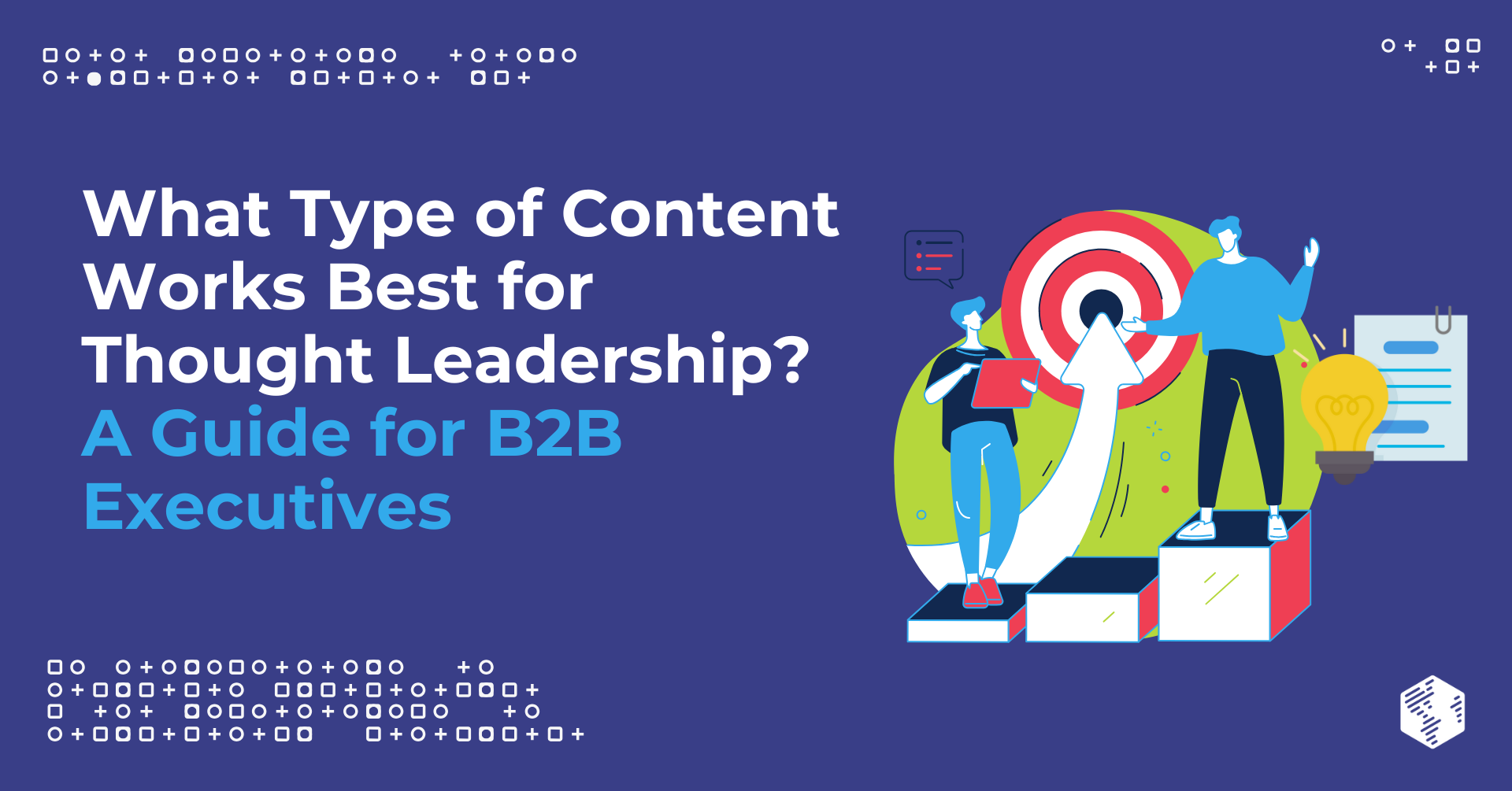Table Of Contents
Trust isn’t won overnight in B2B. Today’s buyers are savvy, skeptical, and saturated with content. To rise above the noise and become a true industry authority, businesses must go beyond selling products and start sharing ideas that inspire action.
The answer is thought leadership. With thought leadership, you deliver genuine value, spark meaningful conversations, and build relationships that go deeper than the transaction.
When you have something meaningful to say, your audience will keep coming back for more.
-Jun-04-2025-08-09-23-5454-PM.png?width=1920&height=1005&name=HubSpot%20Content%20Hub%20for%20Marketers%20(2)-Jun-04-2025-08-09-23-5454-PM.png)
B2B Thought Leadership Content Explained
B2B thought leadership content is original, useful, and informed material that positions a company or individual as a credible expert. It helps your audience solve problems, think differently, or understand a topic more clearly.
Strong thought leadership content is grounded in real-world experience, backed by data, and focused on moving the industry conversation forward. And more:
- It builds credibility and brand trust.
- It influences key decision-makers.
- It shortens sales cycles.
- It drives organic visibility and engagement.
In practice, B2B thought leadership is where marketing meets value. It’s what turns content into conversations and conversations into relationships. When it’s done right, people don’t just read your content—they remember it, share it, and want to work with you because of it.
11 Types of B2B Thought Leadership Content to Choose From
There’s no single way to deliver thought leadership. Each content format offers different benefits depending on who you’re talking to, what stage they’re in, and what you’re trying to achieve.
Here’s a breakdown of formats that work especially well in B2B.
1. Books
Books allow you to dig deep into your ideas and show you know your stuff. They help establish long-term credibility and give people something substantial to take away. Whether it’s a how-to guide or a big-picture view of your industry, a book can anchor your entire thought leadership strategy.
Books are best for senior leaders or founders who want to influence conversations in their field. They also work well as leave-behinds at events, gifts to clients, or tools to earn media attention.
2. Original Research & Insights
People respect data. Original research gives your audience something they can’t find elsewhere. It can take the form a survey, a benchmark report, or a trend analysis; regardless, this kind of content puts your brand at the center of your industry’s biggest questions.
Use clear visuals and plain language to make your data easy to digest. Break it into bite-sized insights for social posts, presentations, and blog content. Good research has a long shelf life and can power multiple campaigns.
3. Digital Hubs & Training Resources
A digital hub—your own library of content, courses, and tools—helps people learn from you at their own pace. It shows your commitment to helping, not just selling. A resource center or an online academy can become a place your audience returns to.
This format works best when you want to support long-term learning, improve customer experience, or generate leads over time.
4. Guides & White Papers
Guides and white papers are great for explaining complex topics in a structured way. Guides tend to be more hands-on and practical, while white papers dig deeper into strategy or industry challenges.
Both can support the middle or bottom of your sales funnel. They help you showcase your expertise and provide value that earns trust. And once they’re published, you can pull insights from them to fuel other types of content.
5. Webinars & Speaking Engagements
Webinars let you connect with your audience live. You can teach, take questions, and build a real-time connection. Speaking at conferences or events puts your voice front and center among peers and prospects.
These formats also give you great recorded content to reuse later. Share clips on social, add them to your resource library, or turn highlights into a blog.
6. Educational Courses
Courses give you the chance to go deeper. They let you walk your audience through complex subjects, one step at a time. Courses can be free to generate leads or paid to generate revenue.
They’re perfect for showing you’re serious about sharing your knowledge, not just promoting your brand. Plus, people who learn from you are more likely to trust and buy from you.
7. Blog Posts & Articles
Blogs and articles are the bread and butter of B2B content. They’re flexible, easy to update, and great for building search traffic. You can respond to trends quickly or dig into evergreen topics that your audience keeps searching for.
These pieces let you keep your brand in the conversation. Over time, they build topical authority that brings more people to your site—and keeps them coming back.
8. Podcasts
Podcasts let you talk to your audience while they go about their day. They’re great for building a loyal following and for sharing behind-the-scenes stories or expert interviews.
Whether you host your own or appear as a guest, podcasts are a simple way to build trust and stay top of mind.
9. Opinion Pieces & Commentary
Want to take a stand? Opinion pieces give you the space to challenge assumptions, highlight trends, or add a unique take. They show that your brand isn’t afraid to have a voice.
Publish these pieces on your own site or pitch them to media outlets. The more timely and relevant, the more attention they’ll get.
10. Guest Posts
Writing for other platforms puts your ideas in front of a broader audience. It helps you build connections and get more visibility while associating your brand with trusted industry voices.
Make sure your guest posts provide fresh insights, not recycled content. Editors and readers can tell the difference.
11. Social Media
Social media is where show up often, build momentum, and stay part of the daily conversation. Share quotes, insights, charts, behind-the-scenes takes, and short clips.
Start with LinkedIn, especially for B2B. But keep an eye on what works for your specific niche—you might find great traction on YouTube, X (Twitter), or even TikTok.
-Jun-04-2025-08-09-24-6944-PM.png?width=1920&height=1005&name=HubSpot%20Content%20Hub%20for%20Marketers%20(3)-Jun-04-2025-08-09-24-6944-PM.png)
How to Choose the Right B2B Thought Leadership Format
Different ideas work better in different formats. The right choice depends on what you’re trying to say, who you’re saying it to, and how much time and budget you have.
Research Audience Preferences
Find out where your audience spends their time and what formats they like best. Do they listen to podcasts during commutes or read long-form guides on the weekend? Use that insight to meet them where they are.
Match to the Funnel Stage
Think about where your target audience is in their buyer’s journey and tailor your thought leadership content to their needs at that stage. Early-stage prospects may prefer blogs or videos. Mid-funnel prospects might want webinars or case studies. Buyers close to a decision may value white papers, detailed guides, or courses.
Consider Your Internal Resources
Look at your team’s strengths. Do you have good writers? A video editor? A graphic designer or social media guru? Choose formats you can create consistently without overloading your team.
Fit the Message to the Format
Some topics are better suited for long-form content, while others are better for quick social takes. Use a format that lets your message breathe—or keeps it tight—based on what’s needed.
Think About Repurposing Potential
Choose content formats that can be repurposed into smaller parts. A single webinar can turn into blog posts, clips, quotes, and more, while a research report can inspire white papers, podcast episodes, educational courses, training resources, and social posts.
Plan for Distribution
A great piece of thought leadership content is useless if no one sees it. Consider how you’ll distribute and promote the content. You could share the content via email, social, paid ads, or partnerships, but the options really are endless. It all depends on where your niche spends their time and how they like to consume thought leadership content.
Test & Adjust
The return on investment (ROI) for thought leadership content can be difficult to measure because it’s focused on sharing ideas, not selling products or services. But there are still metrics you can track and patterns you can analyze to see what’s working (and what isn’t).
Start small, track what performs well, and refine over time. Perfection isn’t necessary. Just aim for progress.
An Example of B2B Thought Leadership: The Beauty of Content Repurposing
Fortunately, you don’t need to start from scratch every time. One strong idea can power a full campaign.
Repurposing is the epitome of working smarter, not harder. It helps you get more value from every piece of content you create.
Say you host a webinar. Here’s what you can do next:
- Turn the transcript into a blog post.
- Cut short clips for social media.
- Pull quotes for LinkedIn graphics.
- Create a downloadable checklist or tip sheet.
- Use the audio as a podcast episode.
- Write a follow-up email series.
- Design a summary infographic.
What does this process look like in action?
At OneIMS, we host a podcast called Coffee with Closers, where business leaders, entrepreneurs, and top-performing sales and marketing professionals share their real-world experiences, growth strategies, and lessons learned. Each episode features candid conversations over coffee that are aimed at helping viewers uncover actionable strategies to drive revenue and accelerate business growth.
In a recent episode, we interviewed Mike “C-Roc” Ciorrocco, an entrepreneur, author, and performance coach who spoke about the concept of omnipresence marketing and provided actionable insights on how to dominate niches through omnipresence.
Afterword, based on that one conversation, we created:
- A detailed blog post optimized for SEO
- An image carousel with bright, engaging visuals
- An article for our Sales & Marketing Insights newsletter
- A recorded version of the interview to drive traffic to our YouTube channel
- LinkedIn posts to spark engagement and conversation
From just one interview, we produced more than five pieces of content. That’s the power of smart repurposing. It extends your reach without doubling your workload.
Conclusion
In B2B, the goal of thought leadership is to be helpful, honest, and consistent. When you share what you know in a way that’s clear and useful, people notice—and they come back for more.
If you’re ready to build a content strategy that works and earns trust along the way, we’re here to help. Let OneIMS help you design a high-impact thought leadership content strategy that resonates with your audience and drives results.
Schedule a consultation today to get started.





